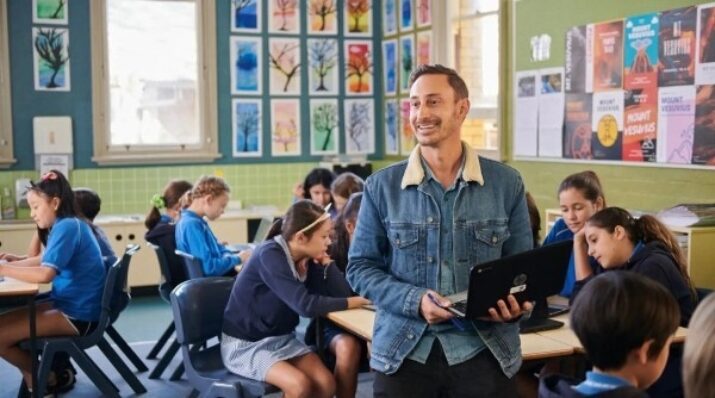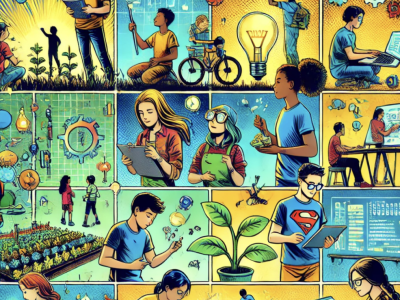Technology Tools
AI in Schools Has Prevailed for a Full Year. What Happens Next?
Topics

Educators often take advantage of educational technologies as they make the shifts in instruction, teacher roles, and learning experiences that next gen learning requires. Technology should not lead the design of learning, but when educators use it to personalize and enrich learning, it has the potential to accelerate mastery of critical content and skills by all students.
Trends suggest AI will be used more and more in schools this year, by teachers and students. Teaching youth to use AI creatively and responsibly can improve deeper learning skills and prepare them for personal and professional success.
Throughout the most recent school year, the introduction of artificial intelligence (AI) into classrooms was met with a mix of curiosity and fear. That’s certainly understandable. While new technology can be exciting, everyone wants students to be safe. Now, after a full school year, it’s clear AI is here to stay—and it will eventually become an essential tool and skill for students, educators, and the workforce.
Here’s what we should expect in the 2025-2026 school year.
AI Usage Will Continue to Increase among Students and Educators.
Responsible AI use is very much possible, and it’s happening. A recent report released by Hopelab, Common Sense Media, and the Harvard Graduate School of Education (HGSE) found half of survey respondents ages 14-22 have used generative AI. Most of those respondents reported they used AI for getting information or brainstorming. Nearly one quarter of students who aren’t using generative AI noted its association with cheating as the reason not to use the technology. While a genuine concern, the mere fear of being associated with cheating was enough to keep them from trying AI.
Though concern is warranted, it’s clear AI is a classmate that isn’t going anywhere. It will play a growing role in education and in the workplace. In fact, it already is! At Canva, we’ve already seen a 107 percent increase over the past year in teacher-approved student usage of our AI tools (Canva for Education gives educators control over which AI features are made available to students). Similarly, the Walton Family Foundation found a 25 percent increase in teacher familiarity with ChatGPT over the past year. Many teachers are quickly embracing AI’s transformative potential and seeking out opportunities to learn what’s possible and teach future skills.
While this growth in use and potential of generative AI isn't unique to schools, schools will be playing a particularly unique role in preparing our future generation in leveraging AI for their personal and professional success.
Beyond use cases like assisting with repetitive tasks, AI has the potential to significantly unlock the inherent creativity in everyone, all while improving classroom instruction.
Teachers Will Lead the Way in Using AI Creatively.
In the classroom, teachers play a crucial role in teaching the complexities of AI. They’re truly rising to the occasion and adapting to new technologies—we've seen a 50 percent increase in AI usage among teachers using Canva tools over the past year. While both students and teachers will increasingly use AI, the real focus is on how they use it in the safest way possible. What I’m most excited about is that, beyond use cases like assisting with repetitive tasks, AI has the potential to significantly unlock the inherent creativity in everyone, all while improving classroom instruction.
Going forward, we'll see educators integrating AI tools into their lessons to enhance the curriculum.
Take Kelly Gibson, a high school English teacher from Oregon, who used Canva's AI text-to-image tool in her class to help students visualize characters in the novels they were reading. This exercise sparked discussions about differing opinions and interpretations of the text and required more creativity than one might think. Students quickly learned generating a perfect representation wasn't as simple as inputting attributes—they had to conceptualize creatively, explain what they were envisioning, refine their prompts through trial and error, and learn how to effectively provide instructions to the AI tool to bring their ideas to life.
Approaches like the project in Gibson’s class not only stimulate deep conversations about the text but also sharpen students' creativity and communication skills and encourage collaboration with AI as a thought partner. These kinds of exercises support both academic learning and the development of essential soft skills—not to mention, digital literacy in the AI era.
AI Skills Will Become an Imperative for the Workforce.
We believe AI is not just a classmate—it’s a future coworker. Students who don’t learn how to work with AI now are at risk of finding themselves at a disadvantage when they enter the workforce. A 2023 study from the University of Pennsylvania found 80 percent of jobs in the U.S. will likely see at least 10 percent of their tasks altered by AI, and almost 20 percent of jobs will see at least 50 percent of their tasks changed.
We don’t believe AI will replace humans. Rather, we believe humans who leverage AI tools will outcompete humans who don’t leverage AI tools.
To best support students and prepare them for this inevitable technological future, we should thoughtfully prepare them now to learn how to leverage AI tools safely and responsibly.
The truth is, we’re all learning about AI together—students, teachers, parents, and even those of us designing AI products. It’s so important that we lean into exploring the technology together to ensure students have meaningful exposure to AI tools, combined with guidance on how to use AI appropriately, and instructions on how to use them effectively. This way, they are prepared for workforce realities they’ll meet.
AI Tools Will Start to Feel Commonplace.
We must remember generative AI tools are still new to everyone. For students, access to these tools means their educational experience is going to look different from those of the adults around them.
Just as we transitioned from calling the internet the "World Wide Web" to experiencing ubiquitous internet access everywhere, AI will become commonplace. By empowering students to view AI as a tool to save time and boost creativity when starting a project, exploring an idea, or solving a problem— and helping them understand how to use it responsibly—we’ll be equipping them to excel in school, life, and work.
As we prepare for the next school year, we should continue to be thoughtful in how we introduce students to AI, leading with curiosity and guidance rather than fear and avoidance.
Photo at top courtesy of Canva.




